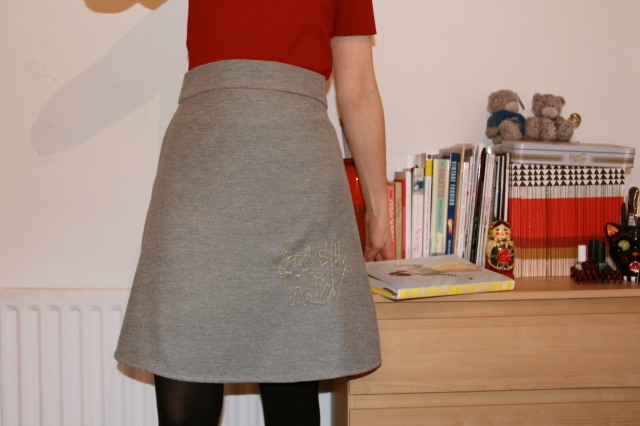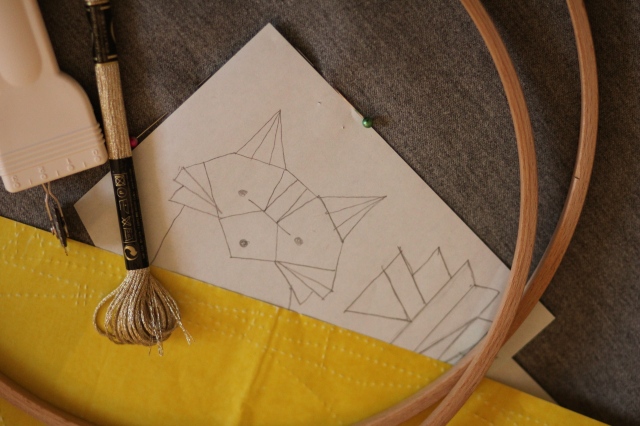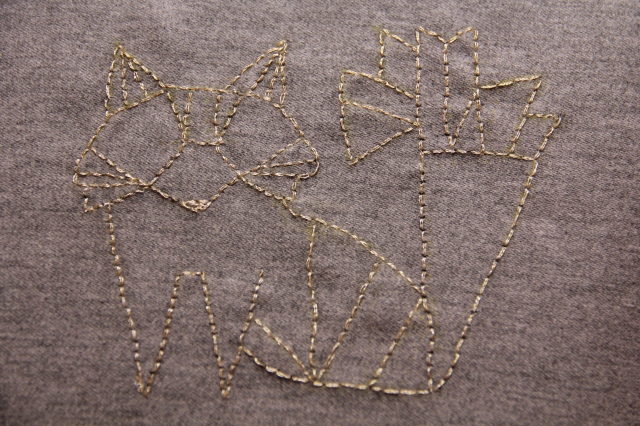
The lil’ fox is incredibly difficult to photograph in my poor-lit house, but the gold thread is much more noticeable in real life.
While making my grey Colette Truffle dress recently, I began thinking about different ways to embellish garments to add a special, personal touch. I love that the Truffle has a simple style as it makes it really easy to accessorize for different situations – it’s a very handy go-to dress to have in the wardrobe – but I was also itching to add something more permanent to it to spice it up a bit.
Around that time, Ingrid of We The Sewing posted about embellishing clothing with embroidery. On reading her tips, I knew that this was exactly the technique I wanted to try out.
So when Tilly Walnes released a preview of the lovely projects included in her new book, Love at First Stitch, I immediately thought of making a simple grey Delphine and trying some hand embroidery. Happily, I still had some of the soft suiting fabric I’ve used on my Frankenskirt and Truffle dress, and I traced out the Delphine pattern as soon as I got my hands on the book.

I pinned a sketch of the fox to the skirt in different places to check the position I wanted before tracing it on to the fabric.
This is my first time embroidering anything on clothes and I followed Ingrid’s great tips for planning the project, from sourcing a simple line drawing via Pinterest (this fox), to tracing the pattern onto the fabric using a wheel and dressmaker’s tracing paper. Initially, I planned to stitch a bright blue or neon pink animal character onto the skirt, but when I was looking through the skein selections at the beautiful haberdasher A Rubanesque, I discovered some amazing metallic DMC threads and decided that gold (shade: E677) would be perfect for this project.
I used an embroidery hoop to keep the skirt fabric tight enough to stitch without puckering, but clamped it loose enough not to crush and mark the fabric. I divided the skein into two-strand threads for sewing because one strand was too light and I was worried that three would tangle. I should note that this metallic thread was more liable to split and fray during sewing so I found it easier to work with shorter lengths, and I just used backstitch.
Here’s a close-up of the finished fox. He’s imperfect, but I like him:
I’m really happy with how this first foray into embroidery embellishment worked out. I like the simplicity of Delphine’s design and the subtle shine of the little golden fox against the soft grey fabric. There’s a stronger contrast between the yellow of the thread and the skirt fabric in real life than in these photos, and the fox sparkles a little when the light catches him.
I also managed to get the invisible zip in really smoothly using my regular zipper foot (yes, I’m done with that pop-on invisible zipper foot!). The Delphine is a lovely simple skirt to sew and, as with all the projects in her book, Tilly includes a range of simple but inspiring ideas for customising your skirt.
I already have two excellent sewing books for learning new techniques, The Colette Sewing Handbook and The Complete Photo Guide to Garment Construction by Christine Haynes (I think Tilly’s book sits somewhere between the two) but I was really drawn to the patterns included in Love at First Stitch. I’m currently working on a Clemence skirt with fabric from my stash and hope to try my hand at the Mimi blouse soon too.
I won’t go into outlining the new book at length as there are already plenty of reviews out there from its blog tour (House of Pinheiro has compiled a particularly good overview), but I do think it’s brilliant value for five lovely and very wearable patterns, as well as being a handy sewing guide. There’s no harm in having more than one reference when you need sewing advice in a pinch – sometimes the different descriptions can help something click better.
A second sewing book I bought recently was a beautiful guide to cross stitch by Sophie Simpson called Storyland Cross Stitch – so I might be trying some cross stitch on clothing soon too!
Have you tried any new clothing embellishment techniques? How did they turn out?


























